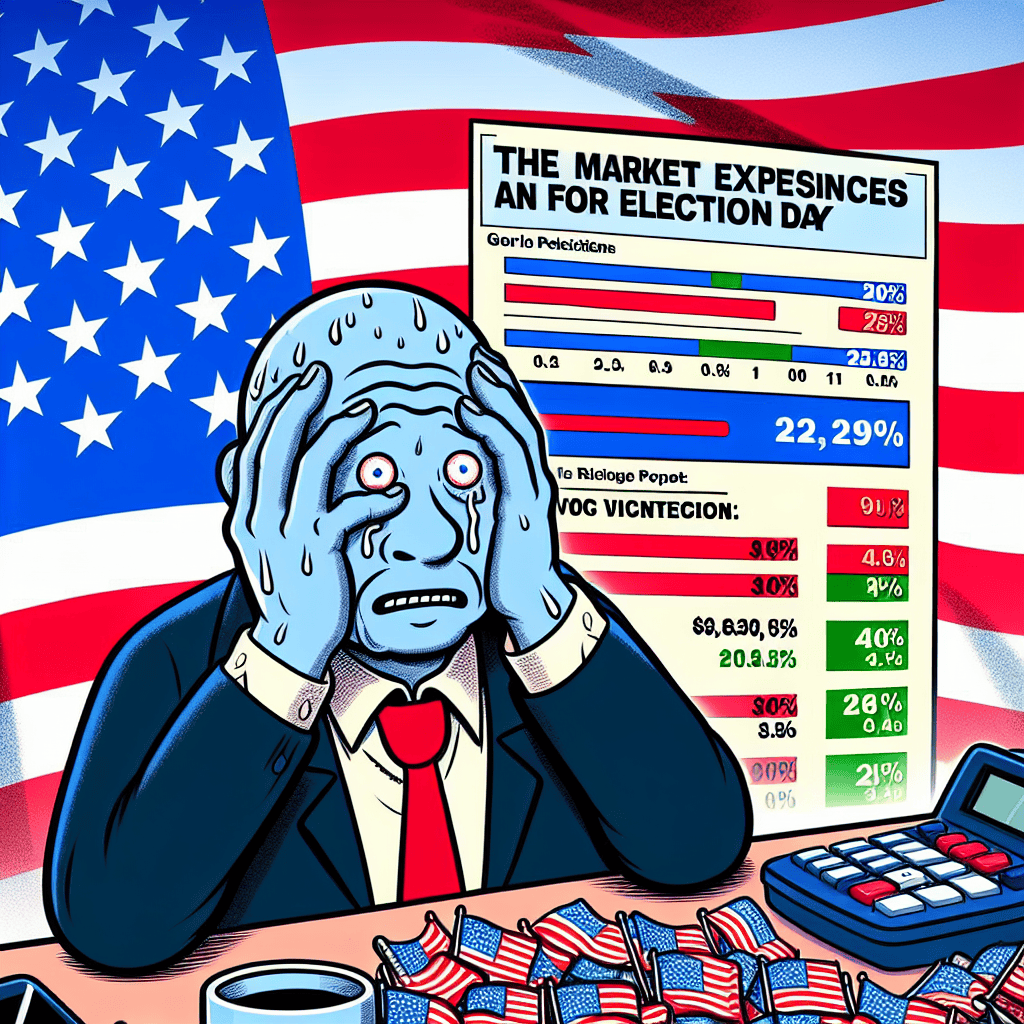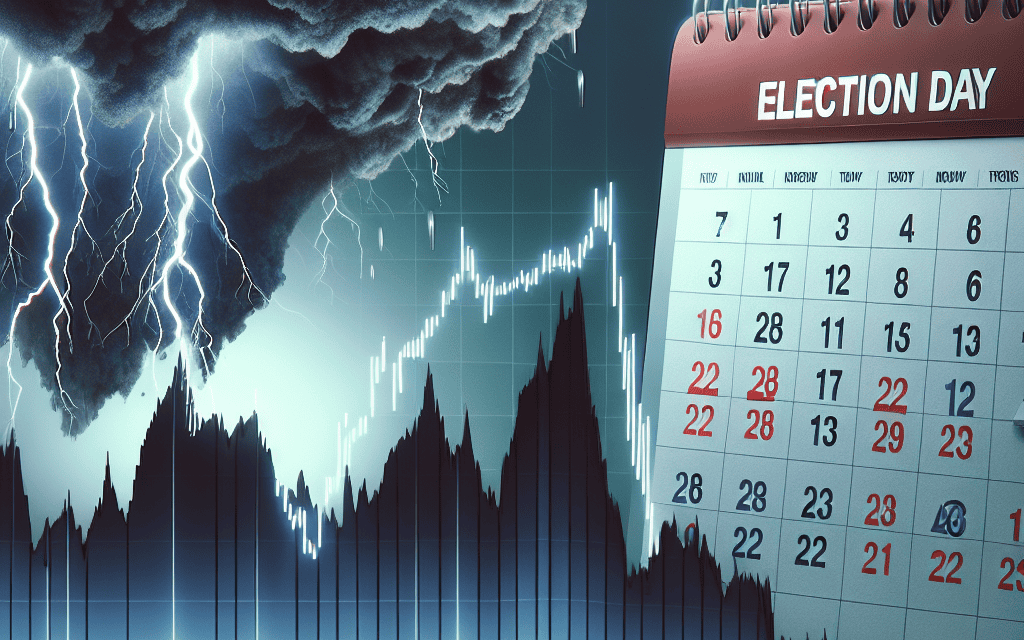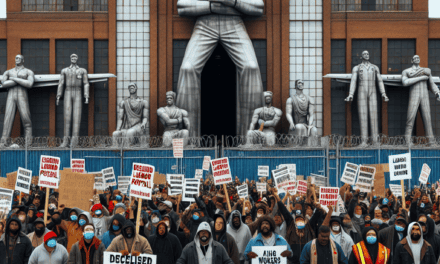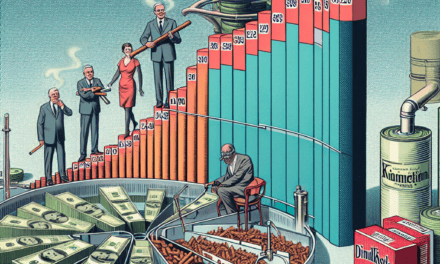“Uncertainty Looms: Markets Brace for Election Day Amidst Low Trump Odds”
Introduction
The anticipation surrounding Election Day is palpable, with market analysts expressing significant apprehension despite forecasts suggesting a low probability of a Trump victory. This unease stems from the unpredictable nature of electoral outcomes and their potential impact on economic stability and investor confidence. Historically, markets have shown sensitivity to political shifts, and the 2020 election is no exception. The specter of policy changes, trade tensions, and regulatory adjustments looms large, prompting investors to brace for volatility. As the nation approaches this pivotal moment, the financial sector remains on edge, wary of the unforeseen consequences that could arise from the electoral process.
Analyzing Market Volatility: Why Election Day Causes Investor Anxiety
As Election Day approaches, the financial markets often find themselves in a state of heightened anxiety, a phenomenon that persists even when predictions of a Trump victory remain low. This recurring pattern of market volatility can be attributed to several factors that intertwine political uncertainty with economic implications. Understanding these dynamics is crucial for investors seeking to navigate the turbulent waters of election cycles.
To begin with, the inherent uncertainty of elections plays a significant role in unsettling the markets. Regardless of the predicted outcome, the mere possibility of an unexpected result can lead to increased volatility. Investors, who typically prefer stability and predictability, find themselves grappling with the potential for policy shifts that could impact economic conditions. This uncertainty is exacerbated by the fact that elections often serve as a referendum on the incumbent administration’s policies, leading to speculation about potential changes in fiscal and regulatory frameworks.
Moreover, the market’s reaction to elections is not solely based on the candidates themselves but also on the broader political landscape. For instance, even if the likelihood of a Trump victory is low, the implications of a divided government or shifts in congressional power can have significant consequences for market sentiment. Investors must consider not only the presidential race but also the composition of Congress, as this determines the feasibility of implementing proposed policies. The interplay between the executive and legislative branches can either facilitate or hinder policy changes, thereby influencing market expectations.
In addition to political factors, economic indicators also contribute to market volatility during election periods. The anticipation of potential policy changes can lead to fluctuations in key economic metrics such as interest rates, inflation, and employment figures. Investors closely monitor these indicators, as they provide insights into the future direction of the economy. For example, a shift in fiscal policy could impact government spending and taxation, thereby affecting corporate profits and consumer spending. Consequently, market participants adjust their portfolios in response to perceived risks and opportunities, leading to increased trading activity and price swings.
Furthermore, the role of media coverage cannot be overlooked in shaping market perceptions during elections. The constant stream of news and analysis can amplify investor anxiety, as headlines often focus on the most dramatic and uncertain aspects of the electoral process. This media-driven narrative can create a feedback loop, where market movements are influenced by public sentiment, which in turn is shaped by media reports. As a result, investors may react to perceived threats or opportunities, even if the underlying fundamentals remain unchanged.
Despite the low probability of a Trump victory, the market’s apprehension is a testament to the complex interplay of political, economic, and psychological factors that characterize election cycles. Investors must remain vigilant and adopt a long-term perspective, recognizing that short-term volatility is an inherent feature of the electoral process. By focusing on fundamental analysis and maintaining a diversified portfolio, investors can mitigate the impact of election-related market fluctuations.
In conclusion, while the market’s fears surrounding Election Day may seem disproportionate given the low predictions of a Trump victory, they are rooted in a broader context of uncertainty and potential change. By understanding the multifaceted nature of election-induced volatility, investors can better prepare for the challenges and opportunities that arise during this critical period.
Historical Trends: How Elections Impact Financial Markets
As the United States approaches another presidential election, the financial markets are once again bracing for potential volatility. Historically, elections have had a significant impact on market behavior, with investors often reacting to the uncertainty and potential policy shifts that accompany a change in administration. Despite predictions suggesting a low probability of a victory for former President Donald Trump, the markets remain on edge, reflecting a broader historical trend where elections induce a sense of apprehension among investors.
To understand this phenomenon, it is essential to examine past election cycles and their influence on market dynamics. Historically, the period leading up to an election is characterized by increased volatility, as investors attempt to anticipate the economic policies of potential candidates and their implications for various sectors. This uncertainty often leads to cautious trading behavior, with many opting to hold off on significant investments until the political landscape becomes clearer. For instance, the 2016 election saw markets initially react negatively to the unexpected victory of Donald Trump, only to rebound as investors recalibrated their expectations based on his pro-business policies.
Moreover, the impact of elections on financial markets is not solely confined to the immediate aftermath of the vote. The months leading up to an election can also see fluctuations, as campaign rhetoric and policy proposals are scrutinized by market participants. This is particularly true when the election outcome is uncertain or when candidates propose significant changes to economic policy. In such scenarios, sectors that are likely to be affected by proposed policies, such as healthcare, energy, and finance, often experience heightened volatility as investors adjust their portfolios in anticipation of potential regulatory changes.
Despite the current predictions indicating a low likelihood of a Trump victory, the market’s apprehension can be attributed to several factors. Firstly, the memory of the 2016 election, where polls and predictions failed to foresee Trump’s win, serves as a cautionary tale for investors. This experience has instilled a sense of skepticism towards election forecasts, prompting market participants to prepare for all possible outcomes. Additionally, the potential for contested results or delays in vote counting, as witnessed in previous elections, adds another layer of uncertainty that can unsettle markets.
Furthermore, the broader economic context in which this election is taking place cannot be ignored. With ongoing concerns about inflation, interest rates, and global economic stability, the stakes are high for investors who are already navigating a complex financial landscape. The prospect of a shift in economic policy, whether through changes in taxation, regulation, or government spending, could have far-reaching implications for market performance. Consequently, even a low-probability event, such as a Trump victory, is enough to keep investors vigilant.
In conclusion, while predictions may suggest a low chance of a Trump victory, the historical trends of market behavior during election periods underscore the inherent uncertainty that accompanies such events. Investors, mindful of past experiences and the current economic climate, remain cautious as they navigate the complexities of an election year. As history has shown, the interplay between politics and markets is intricate, with elections serving as pivotal moments that can reshape investor sentiment and market trajectories. Thus, as Election Day approaches, the financial markets continue to tread carefully, acutely aware of the potential for unexpected outcomes and their subsequent impact.
The Role of Political Uncertainty in Market Fluctuations
Political uncertainty has long been a significant factor influencing market fluctuations, and the anticipation of Election Day often amplifies these effects. As the United States approaches another presidential election, the financial markets are bracing for potential volatility, despite predictions suggesting a low probability of a victory for former President Donald Trump. This scenario underscores the complex relationship between political events and market behavior, where even the perception of uncertainty can lead to significant economic consequences.
Historically, markets have shown sensitivity to political developments, with investors closely monitoring election outcomes that could impact economic policies. The uncertainty surrounding elections can lead to increased market volatility as investors attempt to hedge against potential risks. This is particularly true when the election involves a candidate with a controversial or unpredictable policy agenda, as was the case with Trump during his initial campaign and presidency. Despite current forecasts indicating a low likelihood of his return to office, the mere possibility introduces a degree of uncertainty that markets cannot ignore.
The anticipation of policy changes is a primary driver of market fluctuations during election periods. Investors are keenly aware that different administrations can bring about significant shifts in fiscal, trade, and regulatory policies. For instance, Trump’s previous tenure was marked by substantial tax reforms and trade policy adjustments, which had profound effects on various sectors of the economy. As such, the potential for a similar policy overhaul, even if unlikely, prompts investors to reassess their portfolios in anticipation of possible changes.
Moreover, the psychological aspect of market behavior cannot be overlooked. Markets are not only driven by concrete data and forecasts but also by investor sentiment and perception. The fear of the unknown, particularly in a politically charged environment, can lead to preemptive actions by investors seeking to mitigate perceived risks. This behavior often results in increased market volatility, as seen in the lead-up to previous elections where uncertainty loomed large.
In addition to domestic factors, global considerations also play a role in how markets respond to U.S. elections. The interconnectedness of the global economy means that political developments in the United States can have far-reaching implications. International investors, therefore, keep a close watch on U.S. elections, as changes in American policies can influence global trade dynamics, currency valuations, and international relations. This global perspective adds another layer of complexity to market reactions, further amplifying the effects of political uncertainty.
While current predictions suggest a low probability of a Trump victory, it is essential to recognize that markets operate on a spectrum of probabilities rather than certainties. The mere presence of uncertainty, regardless of its magnitude, can lead to cautious behavior among investors. This cautiousness is often reflected in market trends, with increased demand for safe-haven assets such as gold and government bonds during periods of heightened political uncertainty.
In conclusion, the role of political uncertainty in market fluctuations is a multifaceted phenomenon that extends beyond mere election outcomes. It encompasses the anticipation of policy changes, investor sentiment, and global economic considerations. As Election Day approaches, the markets remain vigilant, acutely aware that even low-probability events can have significant repercussions. This awareness underscores the intricate dance between politics and economics, where the specter of uncertainty continues to wield considerable influence over market dynamics.
Investor Strategies: Navigating Market Fears During Election Season

As election season approaches, investors often find themselves navigating a landscape fraught with uncertainty and volatility. Despite predictions suggesting a low probability of a Trump victory, the market remains apprehensive, reflecting broader concerns about potential disruptions and policy shifts. This apprehension is not unfounded, as historical patterns indicate that markets tend to react to the unpredictability of election outcomes, regardless of the candidates involved. Consequently, investors are compelled to adopt strategies that mitigate risk while capitalizing on potential opportunities.
To begin with, it is essential to understand the underlying reasons for market anxiety during election periods. Elections inherently introduce a degree of uncertainty, as they can lead to significant changes in fiscal and monetary policies. These changes, in turn, can impact various sectors differently, creating winners and losers in the market. For instance, a shift in administration might bring about new regulations or tax policies that could affect corporate earnings and investor sentiment. Therefore, even with predictions favoring a particular outcome, the market remains cautious, as the actual results and subsequent policy implementations can diverge from expectations.
In light of these uncertainties, diversification emerges as a crucial strategy for investors. By spreading investments across a range of asset classes, sectors, and geographies, investors can reduce their exposure to election-related volatility. Diversification not only helps in cushioning against potential losses in one area but also positions investors to benefit from gains in another. For example, while domestic equities might experience turbulence, international markets or alternative assets such as commodities and real estate could offer stability and growth potential.
Moreover, maintaining a long-term perspective is vital during election seasons. Short-term market fluctuations, often driven by emotional reactions to political developments, can lead to impulsive decision-making. Investors who focus on their long-term financial goals and adhere to a disciplined investment approach are better equipped to weather the storm. This involves sticking to a well-thought-out investment plan, rebalancing portfolios as needed, and avoiding the temptation to time the market based on election outcomes.
In addition to diversification and a long-term outlook, investors should also consider the role of defensive assets in their portfolios. Assets such as bonds, gold, and dividend-paying stocks can provide a buffer against market volatility. These investments tend to be less sensitive to political changes and can offer stability and income during uncertain times. By incorporating defensive assets, investors can enhance their portfolio’s resilience and reduce overall risk.
Furthermore, staying informed about potential policy changes and their implications is crucial for making informed investment decisions. Investors should closely monitor developments in key areas such as taxation, healthcare, energy, and trade, as these sectors are often subject to significant policy shifts following elections. By understanding the potential impact of these changes, investors can adjust their strategies accordingly, positioning themselves to take advantage of new opportunities or mitigate risks.
In conclusion, while the market may fear election day despite low Trump victory predictions, investors can navigate this period of uncertainty by employing a combination of diversification, long-term planning, defensive asset allocation, and informed decision-making. By doing so, they can not only protect their portfolios from potential volatility but also capitalize on the opportunities that arise from the evolving political landscape. As history has shown, markets eventually stabilize post-election, rewarding those who remain patient and strategic in their approach.
Comparing Market Reactions: Trump Victory Predictions vs. Reality
In the realm of financial markets, the anticipation of political events often stirs a unique blend of anxiety and speculation. As Election Day approaches, market participants are once again on edge, despite predictions suggesting a low probability of a Trump victory. This apprehension is not without precedent, as the 2016 U.S. presidential election serves as a stark reminder of how market expectations can diverge dramatically from reality. To understand the current market sentiment, it is essential to compare the reactions to Trump’s initial victory predictions with the actual outcomes that followed.
Initially, in 2016, the financial markets were largely unprepared for a Trump presidency. Polls and forecasts overwhelmingly favored Hillary Clinton, leading to a sense of complacency among investors. However, as the election results began to unfold, the unexpected Trump victory sent shockwaves through global markets. Overnight, stock futures plummeted, and the volatility index spiked, reflecting the uncertainty and fear that gripped investors. Yet, in a surprising turn of events, markets quickly rebounded, with the Dow Jones Industrial Average and other indices reaching record highs in the months that followed. This rapid recovery was fueled by optimism surrounding Trump’s pro-business policies, including tax cuts and deregulation.
Fast forward to the present, and the market’s cautious stance towards the upcoming election is palpable. Despite predictions indicating a low likelihood of Trump reclaiming the presidency, investors remain wary. This caution can be attributed to several factors. Firstly, the memory of 2016’s polling inaccuracies lingers, reminding market participants that predictions are not infallible. Secondly, the current political climate is fraught with heightened polarization and uncertainty, which can exacerbate market volatility. Furthermore, the potential for contested election results or delayed outcomes adds another layer of complexity to the market’s calculus.
In addition to these considerations, the economic landscape has evolved significantly since Trump’s first election. The COVID-19 pandemic has reshaped global economies, introducing new challenges and uncertainties. As a result, investors are keenly aware that the stakes are higher this time around. The prospect of policy shifts, particularly in areas such as healthcare, technology regulation, and international trade, could have profound implications for market dynamics. Consequently, even with low Trump victory predictions, the market’s apprehension is understandable.
Moreover, the market’s reaction is not solely driven by the potential for a Trump victory. The broader implications of the election, regardless of the outcome, are equally significant. Investors are closely monitoring the potential for changes in fiscal policy, infrastructure spending, and environmental regulations, all of which could impact various sectors differently. This multifaceted landscape necessitates a cautious approach, as market participants weigh the potential risks and rewards associated with different electoral scenarios.
In conclusion, while predictions of a Trump victory remain low, the market’s fear of Election Day is rooted in a complex interplay of historical precedent, current political dynamics, and economic uncertainties. The lessons of 2016 serve as a reminder that markets can react unpredictably to political events, and the stakes in the current election are undeniably high. As investors navigate this uncertain terrain, they must remain vigilant, balancing caution with the potential opportunities that may arise in the aftermath of the election. Ultimately, the market’s reaction will hinge on its ability to adapt to the evolving political and economic landscape, underscoring the intricate relationship between politics and financial markets.
The Influence of Media on Market Sentiment During Elections
As the United States approaches another pivotal election day, the financial markets are once again gripped by a palpable sense of anxiety. Despite predictions indicating a low probability of a victory for former President Donald Trump, the markets remain on edge, reflecting a broader concern about the potential for unexpected outcomes. This apprehension is not merely a reflection of political uncertainty but is significantly influenced by the media’s portrayal of the electoral landscape. The media, with its vast reach and ability to shape public perception, plays a crucial role in influencing market sentiment during election periods.
To understand this phenomenon, it is essential to consider how media narratives can amplify market fears. In the lead-up to elections, media outlets often focus on the most dramatic and contentious aspects of the political process. This focus can create a heightened sense of uncertainty, as investors are bombarded with headlines that emphasize potential risks and disruptions. For instance, discussions about contested results, legal challenges, or civil unrest can lead to increased volatility in the markets, as investors brace for the worst-case scenarios. Even when statistical models and expert analyses suggest a low likelihood of such outcomes, the media’s emphasis on these possibilities can overshadow more measured assessments.
Moreover, the media’s role in shaping market sentiment is not limited to the content of its coverage but also extends to the frequency and intensity of its reporting. In the digital age, news cycles are relentless, with updates and analyses available around the clock. This constant stream of information can exacerbate market jitters, as investors react to each new development, often without the benefit of a broader context. The rapid dissemination of news can lead to knee-jerk reactions in the markets, as traders and investors seek to preemptively position themselves in response to perceived threats.
In addition to the direct impact of media coverage on market sentiment, there is also an indirect effect that arises from the media’s influence on public opinion. As the media shapes the narratives that dominate public discourse, it can also affect the broader economic environment by influencing consumer confidence and spending behavior. If the public perceives the election as a source of instability, this perception can lead to reduced consumer spending and business investment, further contributing to market volatility.
Despite these challenges, it is important to recognize that the media also plays a vital role in providing transparency and accountability during elections. By scrutinizing the electoral process and highlighting potential irregularities, the media helps to ensure the integrity of democratic institutions. However, this watchdog role must be balanced with a responsibility to provide accurate and nuanced reporting that does not unduly alarm the public or the markets.
In conclusion, while the media’s influence on market sentiment during elections is undeniable, it is a complex interplay of factors that extends beyond mere reporting. The media’s ability to shape narratives, combined with the rapid pace of information dissemination, can amplify market fears, even in the face of low-probability events. As election day approaches, investors would do well to remain vigilant but also discerning, recognizing the distinction between media-driven narratives and the underlying economic fundamentals. By doing so, they can navigate the uncertainties of the electoral landscape with greater confidence and resilience.
Understanding the Disconnect: Low Trump Victory Predictions and Market Concerns
As the United States approaches another pivotal election day, the financial markets are exhibiting a level of anxiety that seems disproportionate to the current predictions of a Trump victory. Despite numerous polls and political analysts suggesting a low probability of former President Donald Trump reclaiming the White House, market participants remain on edge. This apparent disconnect between electoral forecasts and market behavior warrants a closer examination of the underlying factors contributing to this unease.
To begin with, it is essential to recognize that financial markets are inherently forward-looking, often reacting not just to current events but to potential future scenarios. While the probability of a Trump victory may be low according to prevailing forecasts, the markets are acutely aware of the unpredictability that characterized the 2016 election. The memory of that unexpected outcome lingers, serving as a cautionary tale that fuels apprehension. Consequently, investors are wary of underestimating the potential for a similar surprise, which could lead to significant policy shifts and economic implications.
Moreover, the markets are not solely concerned with the binary outcome of who wins the presidency. Instead, they are attuned to the broader implications of the election, including potential changes in fiscal policy, regulatory environments, and international relations. A Trump victory, while currently deemed unlikely, could herald a return to the policies of his previous administration, which included tax cuts, deregulation, and a more confrontational stance on trade. These factors could have profound effects on various sectors, from technology to manufacturing, thereby influencing market sentiment.
In addition to policy considerations, the markets are also sensitive to the potential for heightened political polarization and social unrest, which could accompany a contentious election outcome. The prospect of prolonged legal battles, disputed results, or civil unrest could introduce significant volatility and uncertainty, conditions that markets typically seek to avoid. This potential for instability, regardless of the election’s outcome, contributes to the prevailing market jitters.
Furthermore, it is important to consider the role of investor psychology in shaping market dynamics. The fear of missing out, or FOMO, can drive market participants to act defensively, even in the face of seemingly low-probability events. This behavior is compounded by the interconnectedness of global markets, where developments in one region can have ripple effects worldwide. As such, even a localized political event like the U.S. election can have far-reaching consequences, prompting investors to hedge their bets and adopt a cautious stance.
In light of these factors, it becomes evident that the market’s apprehension is not solely a reflection of the likelihood of a Trump victory but rather a response to the broader spectrum of uncertainties that elections inherently bring. While the predictions may suggest a low probability of a Trump win, the markets are preparing for a range of possible outcomes, each with its own set of challenges and opportunities. As election day approaches, this cautious approach underscores the complex interplay between political developments and market behavior, highlighting the need for investors to remain vigilant and adaptable in navigating the ever-evolving landscape.
Q&A
1. **Question:** What are the main concerns of the market regarding Election Day?
– **Answer:** The market fears potential volatility and uncertainty due to contested election results, policy shifts, and changes in economic direction depending on the election outcome.
2. **Question:** Why are Trump victory predictions considered low?
– **Answer:** Polls and statistical models at the time may show a significant lead for his opponent, reflecting public sentiment and historical voting patterns that suggest a lower probability of a Trump victory.
3. **Question:** How might a contested election impact the market?
– **Answer:** A contested election could lead to prolonged uncertainty, legal battles, and delayed policy implementation, causing market instability and investor anxiety.
4. **Question:** What sectors are most likely to be affected by election outcomes?
– **Answer:** Sectors such as healthcare, energy, and technology could be significantly impacted due to potential regulatory changes and shifts in government priorities.
5. **Question:** How do investors typically hedge against election-related market volatility?
– **Answer:** Investors might use strategies such as diversifying portfolios, investing in safe-haven assets like gold, or using options and futures to manage risk.
6. **Question:** What role do economic policies play in market fears related to elections?
– **Answer:** Economic policies, including tax reforms, trade agreements, and fiscal stimulus, can greatly influence market performance, and uncertainty about these policies can heighten market fears.
7. **Question:** How do historical election outcomes influence current market predictions?
– **Answer:** Historical trends and outcomes provide a framework for predicting market reactions, as investors analyze past election impacts on economic indicators and stock performance to inform current expectations.
Conclusion
The market’s apprehension surrounding Election Day, despite predictions of a low probability of a Trump victory, can be attributed to several factors. Firstly, markets generally dislike uncertainty, and elections inherently bring unpredictability, especially in a polarized political climate. Even with low odds of a Trump win, the potential for unexpected outcomes or contested results can create volatility. Additionally, markets may be concerned about policy shifts, regulatory changes, or geopolitical tensions that could arise from the election, regardless of the victor. This fear is compounded by the memory of the 2016 election, where many predictions were proven wrong, leading to a cautious approach by investors. Therefore, the market’s nervousness reflects a broader concern about stability and the potential for unforeseen consequences that could impact economic conditions and investor confidence.





